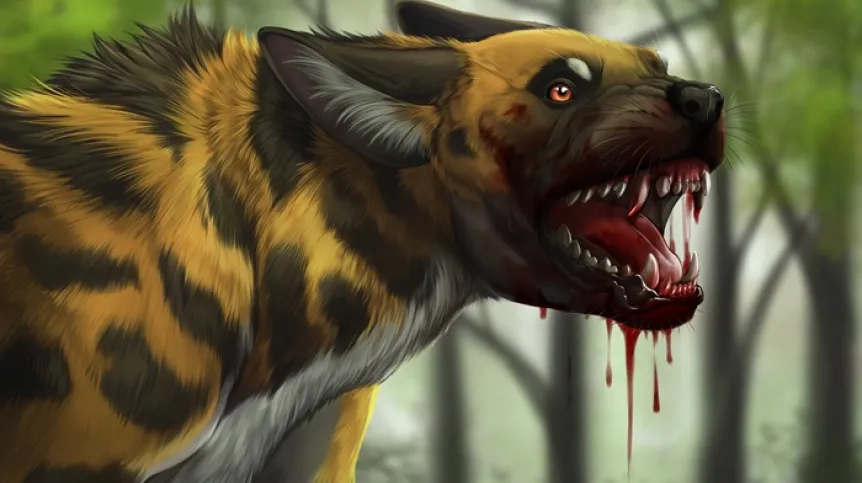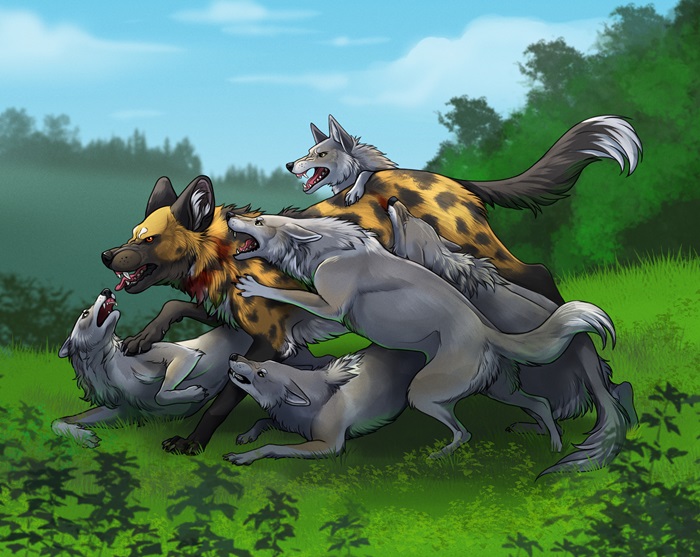
We know lycaons from Africa, but about half a million years ago these predatory mammals also existed in the lands of today's Poland. Scientists who examined the remains of the last Eurasian lycaon from the Wieluń Upland call it the canine Jack the Ripper. It was able to knock down very large prey and eat its entire body.
The Wieluń Upland, located in southern Poland between Wieluń and Częstochowa, is an extremely picturesque area, but still little explored palaeontologically, despite its enormous potential and wealth. It is ideal for palaeontological and speleological expeditions and all kinds of physical activity, says Dr. Adrian Marciszak from the University of Wrocław, head of the Department of Evolutionary Biology and Vertebrate Conservation at the Faculty of Biological Sciences.
Draby 3 is a site in the Wieluń Upland, approximately 6 km southwest of Działoszyn (Łódź Voivodeship), which contains the remains of a Eurasian lycaon. It was there that the last relic occurrence of this species in the lands of today's Poland was found. A paper devoted to it was published in Quaternary International. The co-authors of the publication are Wiktoria Gornig from the University of Wrocław and Adam Szynkiewicz from KART-GEO in Wrocław.
Canines of the Lycaon genus appeared in Europe approx. 2.6 million years ago, and their morphology remained almost unchanged for the next 2 million years, reminds Dr. Marciszak. He adds that over the following 2 million years, the presence of two large canids in Eurasia was well documented: the large lycaon and the smaller wolf (Canis etruscus/mosbachensis). Of the two species, the long-legged lycaon was much larger and dominated open grasslands.
Lycaon probably had a negative impact on the wolf population, says Gornig.
'The much more numerous but smaller wolf may have been killed and driven away from prey by the larger lycaon because larger canids tend to dominate smaller species. Where larger canids occur, smaller species may modify their distribution, behaviour, and pack size to reduce interspecies competition or aggression. Moreover, the numbers of smaller dogs may be reduced compared to areas free from larger dogs,’ says Dr. Marciszak.

'The Eurasian lycaon (Lycaon falconeri/lycaonoides) was morphologically similar to the modern African wild dog (Lycaon pictus), but on average twice as heavy and more massively built. Its large size, exceeding the largest modern wolves, was an undeniable advantage during hunting. It hunted just like the African wild dog, persistently chasing its prey in a pack and then literally eviscerating it. Powerful teeth with strongly developed cutting edges and massive jaws were perfect for this task, which involved attacking the defenceless, soft underbelly, causing the victim to die in just a few minutes as a result of shock and blood loss. The prey defending itself with hooves or antlers would often die even faster because, unsuccessfully trying to hit one attacker, it would expose itself to the attack of others,’ Marciszak says.
According to the researchers' analyses, the lycaon occupied a 'peculiar ecological niche not reflected in any modern species'. It was able to knock down a very large prey and its body was consumed entirely thanks to the lycaon's extremely strong jaws and teeth.
'The Eurasian lycaon was a member of a fairly stable fauna of predatory mammals with an old pedigree, among which it occupied one of the dominant positions,’ says Marciszak.
He adds that since the Middle Pleistocene (approx. 0.8 million years), there was a noticeable increase in body size as a possible response to the growing competition from two large newcomers of African origin. Their appearance led to a complete reconstruction of the carnivore fauna. The first to appear was the cave hyena (Crocuta crocuta), which quickly led to the extinction of the giant short-faced hyena (Pachycrocuta brevirostris). Shortly afterwards, the huge steppe lion (Panthera spelaea fossilis) appeared, which led to a drastic decline and almost complete disappearance of Homotherium latidens and the European jaguar (Panthera gombaszoegensis).

'Shortly after their arrival in Europe, approximately 0.9-0.8 million years ago, an increase in the size of the Eurasian lycaon is observed. This may be lycaon's reaction to a significant increase in the level of competition, because larger size is one of the features that give an advantage in aggressive encounters. Larger specimens of South African wild dog populations compete and fight more effectively than their eastern, smaller relatives. The increase in body size may have given the lycaon a momentary advantage or offset the powerful influence of new opponents and allowed it to compete successfully. It could be one of the reasons why lycaons survived for so long. However, their range in the Middle Pleistocene probably gradually decreased, because from that period we no longer observe sites, for example, from southern Europe or western and central Asia. The lycaon survived, but competition and changes in fauna caused by climate change resulted in a gradual reduction of its range and probably also its numbers. For such a large, pack-hunting dog, where success depends on the size of the pack, this state of affairs was unbearable. The lycaon gradually lost and the smaller and more adaptable wolf gained,’ says Marciszak.
During the massive glaciation MIS 12 (478-424 thousand years ago), the more thermophilic lycaon probably retreated to the southern and eastern refugia. The wolf, better adapted to the cold, remained in place, gradually increased its numbers and took over the ecological niche vacated by the lycaon, suggest scientists who study the remains of these species.
The MIS 12 glaciation was one of the strongest Quaternary glaciations. It was during that time that the continental ice sheets in the Northern Hemisphere reached their furthest. 'The significant impact of this extreme glaciation on terrestrial ecosystems in Central and Eastern Europe was very strong. It is likely that during MIS 12 the impact of the harsh climate, changes in the ungulate fauna and increasing competition from the steppe lion and cave hyena caused a drastic reduction in the numbers and range of the lycaon. Balance between predators was disrupted and a certain critical point in the lycaon-wolf relationship had been crossed. Probably by the time of MIS 11 the lycaon was already too rare to constitute a real competition and a limiting factor for the wolf. It was also the time when the lycaon completely disappeared from Eurasia and its remains from sites younger than MIS 11 are not yet known. As soon as the lycaon disappeared from Eurasia, a significant increase in the size of the wolf is observed,’ Marciszak says.
'Further excavations are planned in the coming years, because this discovery is just one of several equally interesting ones,’ he adds.
PAP - Science in Poland
zan/ bar/ kap/
tr. RL













